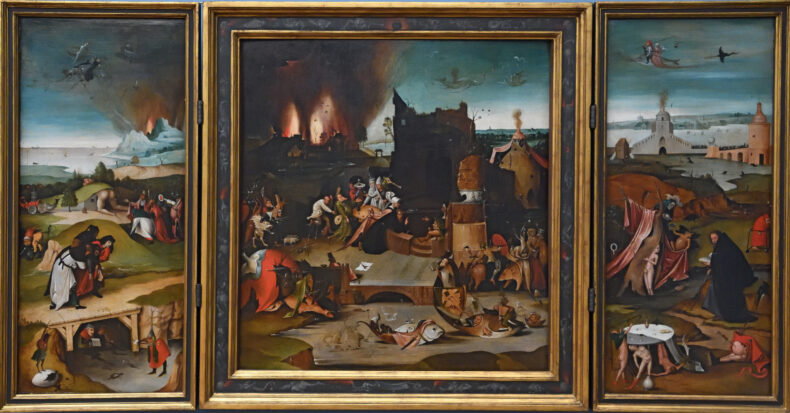
Hieronymous Bosch, the Temptation of St. Anthony. Via Wikimedia Commons.
When I was a student studying literature, I kept seeing Christ allegories everywhere. I remember being assigned The Old Man and the Sea, one of many Hemingways I read that semester, and I remember my teacher asking what we thought the book was about. Answers included “death’s inevitability” and “the fallacy of humanity’s power over nature” and other tropes. But it was about Christ. It was undeniably about Christ and Santiago was his avatar. He holds the rope for three days, and it cuts his palms like the stigmata; that much I still remember.
So much of art and literature and cinema offers the same allegory, and some stories and characters are of course more obvious than others. Aslan in The Lion, the Witch, and the Wardrobe is obvious; Anakin Skywalker in Star Wars: the Phantom Menace maybe less so, but watch it again. Ripley in Alien 3, Neo in the Matrix trilogy, Superman in Zack Snyder’s Man of Steel, every single Mel Gibson character.
But in the past few years, Christ has become less obvious to me. Or, at least, the greatest story ever told is no longer the prevailing motif in the stories I read and watch. There is a different sacrificial lamb, a different tragedy, though I suppose a similar foil. All stories are climate allegories.
I started thinking about this a few years ago, but it has felt ever more present in this summer of hellish fire and heat. The first time a climate allegory became obvious to me was the sparkling 2012 novel The Age of Miracles. It is about a girl going through puberty, as she and her family experience personal crises against the backdrop of planetary calamity. The calamity is a sudden inexplicable slowing of Earth’s rotation, but the connection to climate change was evident.
A writer colleague recently asked, in a large group, for suggestions of books that are climate allegories, whether obvious or not. Her main example was Barbara Kingsolver’s lovely Flight Behavior, a beautiful climate change story that has stuck with me over the years. My colleague was hoping to avoid speculative fiction or science fiction/fantasy, but was open to any ideas. The suggestions rolled in, again some obvious and some less so: Remarkably Bright Creatures, by Shelby Van Pelt; Migrations, by Charlotte McConaghy; The Overstory, by Richard Powers; and Birnam Wood, by Eleanor Catton, were among my favorite recommendations. I said the Fifth Season trilogy, by N.K. Jemisin — yes, it is science fiction/fantasy, but some of the best writing I’ve read in recent years, and to my mind definitely climate fiction.
I started thinking about whether these books were intended as climate allegories, or whether the moment in which they were written is just so suffused with that reality, the climate connection was more organic. I don’t know. But I like thinking about it.
TV and movies are the same way. Everything is a climate story now. My favorite show lately was Silo, based on some of my absolute favorite speculative fiction books, the Wool series by Hugh Howey. I was one of the lucky people who found Wool on Kindle, back when it was new and fresh technology, and waited desperately for Howey to upload his next installments. The books read as climate or nuclear fiction, but they felt somehow fun to me then, not so suffused with dread. The TV adaptation, starring Rebecca Ferguson (never enough, never, never; also Lady Jessica), feels different. It was more darkly like a story about climate apocalypse. I won’t spoil it — you should really just read the Wool Omnibus — but suffice to say that it has the same feeling, dread mixed with longing and nostalgia and solastalgia, that is shared by movies like Children of Men, Blade Runner: 2049, and Interstellar.
I thought about the Old Man and the Sea when we watched Avatar: The Way of Water with my 8-year-old. (OK, fine, Jake Sully’s “They killed their mother” is not exactly allegorical, but Avatar is still a climate movie.) The space whales movie tries to be a lot of things, but I kept coming back to ocean acidification and the 101 degree temperatures in the south Atlantic this summer. Is that what James Cameron wanted me to think about? The deep-sea submersible diver and HMFIC hitting me over the head with mournful whale families? It’s true that some of the greatest stories getting told are, in fact, trying to talk about climate, sometimes to give the productions greater meaning, sometimes to give voice to the feeling of living and creating right now. My friend explored this in depth in a feature in The Atlantic, which you should read.
Or maybe it’s also true that I am seeing these metaphors because my mind is primed to see them. I live in narratives, so of course I look for meaning behind them, and right now the most meaningful thing I can imagine is what we have done to this planet. Books are all about climate, movies and TV shows are all about climate, because my mind is all about climate. It is the main theme I obsess over, the future I try to imagine on behalf of my kids; climate fiction is the Baader-Meinhof phenomenon.
If, as someone once said, the aim of art is to represent not the outward appearance of things, but their inner significance, then I suppose it’s ok that I am seeing climate stories everywhere. It may be as the artists intended. It may be the meaning that I, the consumer of art, am bringing to the experience. The story gets told either way.
Sorry, Santiago. I still think you are a version of Christ. But I do wonder, if Hemingway were writing now, whether The Old Man and the Sea would be about rising seas instead.
One thought on “The New Greatest Story Ever Told”
Comments are closed.